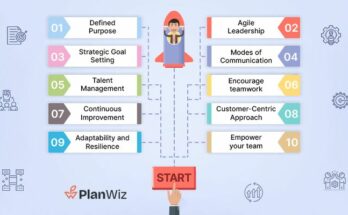Are you drowning in a sea of tasks, unsure where to start? Discover the ultimate solution to reclaim your productivity with our guide on task prioritization! Unveiling seven essential steps, we’ll equip you with the tools to supercharge your workflow, tackle deadlines head-on, and unleash your full potential. Say goodbye to exhaustion and hello to performance as we decode the art of task prioritization together.
In our blog, Task Prioritization: 7 Vital Steps To Empower Your Workflow, we share key strategies for enhancing productivity. Through seven essential steps, readers learn to manage tasks effectively and achieve success. From prioritizing to mastering time management, this guide offers a streamlined approach. Prepare to seize control and unlock your potential.
Step 1: Understand Your Goals

Understanding your goals is the cornerstone of any successful endeavor. It’s crucial to clarify what you aim to achieve before taking action. Whether personal or professional, setting clear and specific goals provides direction and motivation.
To understand your goals, it’s essential to reflect on your values, passions, and aspirations. This introspection helps align your goals with what truly matters to you, ensuring they are meaningful and fulfilling. By identifying your priorities and incorporating them into your to-do list priorities, you can focus your efforts on what will bring the most satisfaction and fulfillment in the long run.
Breaking down your goals into smaller, manageable tasks can make them more achievable. Setting milestones allows you to track progress and adjust your approach as needed. Additionally, prioritizing your goals helps you allocate your time and resources effectively, maximizing your chances of success.
Once you’ve clarified your goals and set milestones, maintaining adaptability is key. Embrace challenges as opportunities for growth, adjusting your strategies when needed. Stay resilient, knowing that setbacks are part of the journey. With determination and flexibility, you can navigate any obstacles toward success.
- Clear goals lead to success.
- Reflect on values for direction.
- Break tasks, and set clear milestones.
- Embrace adaptability, and conquer setbacks.
Step 2: Revise task prioritization techniques

Task prioritization is essential for effective time management, and employing various techniques can significantly enhance productivity. One such method is the “Eat the Frog” approach, which emphasizes tackling the most challenging or important task first. By addressing the most daunting task early on, individuals can alleviate stress and increase their overall efficiency in completing subsequent tasks.
Another valuable technique is the Eisenhower Matrix, which categorizes tasks based on their urgency and importance. This method helps individuals differentiate between tasks that are both urgent and important, those that are important but not urgent, urgent but not important, and neither urgent nor important. By systematically organizing tasks into these categories, individuals can allocate their time and resources more effectively.
The ABCDE Method offers a structured approach to task prioritization by assigning priorities to each task based on its significance. Tasks are categorized as A (most important), B (important), C (nice to do but not critical), D (delegate), and E (eliminate). This method encourages individuals to focus on completing tasks with the highest priority first, ensuring that time is allocated efficiently to tasks that align with overarching goals and objectives.
Integrating these task prioritization techniques into daily routines can lead to enhanced productivity and reduced stress levels. Whether tackling the toughest tasks first with the “Eat the Frog” approach, organizing tasks by urgency and importance using the Eisenhower Matrix, or systematically assigning priorities with the ABCDE Method, individuals can optimize their time management strategies to achieve greater success in both personal and professional endeavors.
1. Eat the Frog Technique:
Prioritize tackling the most challenging or unpleasant task first thing in the morning.
Identify Your Frog: Pinpoint the toughest task on your daily agenda.
Eat It: Tackle it head-on without delay, prioritizing it in the morning.
Repeat Daily: Transform this practice into a habit to enhance productivity consistently.
2. Eisenhower Matrix:
- Urgent and Important: Tasks that require immediate attention and are crucial to your goals.
- Important, but Not Urgent: Tasks that contribute to your long-term objectives but can be scheduled for later.
- Urgent, but Not Important: Tasks that demand immediate action but don’t align with your overall goals. Consider delegating or minimizing time spent on these.
- Not Urgent, Not Important: Low-priority tasks that can be eliminated or postponed indefinitely.
3. ABCDE Prioritization:
- A Tasks: High-priority tasks that are critical to your success. Complete these first.
- B Tasks: Important tasks that should be done but are less urgent than ‘A’ tasks.
- C Tasks: Tasks that you could do, but they wouldn’t significantly impact your goals.
- D Tasks: Delegate these tasks to others if possible.
- E Tasks: Eliminate or postpone these tasks as they don’t contribute to your objectives.
Step 3: Break Down Complex Tasks

Breaking down complex tasks into smaller, more manageable components is crucial for enhancing productivity and reducing overwhelm. Individuals can approach tasks with clarity and focus by dissecting large projects or assignments into smaller, actionable steps, making them easier to tackle and complete with the assistance of a daily planner app.
Begin by identifying the key components or stages involved in accomplishing the task. Then, break these components down further into actionable steps or subtasks. Assigning deadlines or milestones to each subtask can help track progress and maintain momentum.
Moreover, breaking down complex tasks allows for better delegation and collaboration if necessary. By clearly defining each component, individuals can effectively communicate expectations and distribute responsibilities among team members.
Remember to remain flexible and adapt your approach as needed throughout the process. As you progress, reassess the breakdown of tasks and adjust accordingly to ensure optimal efficiency and effectiveness.
Moreover, keeping in touch regularly and assessing our progress is important. These check-ins provide an opportunity to celebrate successes, adjust our strategies as necessary, and ensure we’re all working towards the same goal effectively.
- Identify stages and break down tasks.
- Set deadlines and track progress.
- Enhance delegation and encourage collaboration.
- Stay flexible and adjust strategies.
Step 4: Consider Resources and Constraints

When it comes to deciding what tasks to tackle first, it’s crucial to consider the resources and limitations at hand. This means taking into account factors like time, manpower, and budget. By understanding these constraints, prioritizing tasks becomes a strategic process aimed at getting the most done within the boundaries you have to work with.
Task prioritization involves weighing various projects or activities against the resources available. It necessitates a thorough evaluation of both tangible resources like finances and manpower, as well as intangible ones such as expertise and time. Aligning priorities with available resources helps streamline workflows and optimize productivity.
Within the framework of task prioritization, constraints can serve as guiding parameters, steering the focus toward the most impactful endeavors. By recognizing limitations early on, teams can proactively strategize and allocate resources judiciously, ensuring that critical tasks are addressed promptly. Constraints thus become catalysts for creative problem-solving and effective resource management.
Understanding limitations helps teams find better ways to list priorities things. Embracing constraints makes teams stronger and more adaptable. This helps them overcome problems and achieve their goals. Using limitations wisely can lead to new ideas and better results for Organizational strategies.
- Prioritize tasks based on resources.
- Evaluate constraints for strategic planning.
- Align priorities with available resources.
- Embrace limitations for creative solutions.
Step 5: Identify High-Value Activities

Task prioritization is essential for identifying high-value activities within any project or endeavor. By meticulously assessing the importance and urgency of each task, individuals or teams can allocate their time and resources more effectively. This process involves evaluating the potential impact of each activity on the overall goal or objective, ensuring that efforts are directed towards tasks that yield the greatest value.
Through task prioritization, individuals can focus on activities that contribute most significantly to the desired outcomes, maximizing productivity and efficiency. This strategic approach helps prevent time wastage on trivial tasks or those with minimal impact, enabling individuals to channel their energy towards endeavors that generate tangible results. By consistently prioritizing tasks based on their value, individuals can optimize their workflow and achieve better outcomes in both professional and personal spheres.
Good task prioritization involves recognizing importance and managing resources wisely. Allocate time and energy to high-value tasks for optimal results. Regularly reassess priorities within your to-do list priorities for adaptability and resilience in achieving goals.
Focusing on the important stuff first helps you see what matters and gives you a clear path to follow. It’s like having a roadmap that guides you towards your goals. When you’re clear about what’s important, making decisions becomes easier, and you can concentrate on tasks that count. By sticking to activities that bring the most value, you can handle tricky situations better and keep growing and succeeding in what you do.
- Assess the Importance and Urgency
- Maximize Productivity with Prioritization
- Focus on High-Value Tasks
- Adaptability for Goal Achievement
Step 6: Use Technology to Your Advantage

In today’s fast-paced world, technology offers incredible tools like the Planwiz Planner to help with task prioritization. With just a few clicks or taps, you can organize your to-do list efficiently. Task prioritization becomes effortless with apps and software designed to streamline your workflow.
Using technology for task prioritization allows you to allocate your time and resources effectively. Whether it’s scheduling reminders or creating categorized lists, digital tools make it simple to stay on top of your to-do list priorities. With the help of these tools, you can ensure that important tasks are completed on time.
Technology also offers insights into your productivity habits, aiding in smarter task prioritization and time management tips. Reviewing data from productivity apps can show where you’re investing excessive time and where tweaks are necessary. Utilizing these insights allows you to improve your prioritization strategy for enhanced efficiency.
technology provides valuable insights into your productivity habits, facilitating smarter task prioritization. By reviewing data collected from productivity apps, you can pinpoint areas where you might be investing excessive time and identify areas in need of adjustment. Leveraging these insights enables you to refine your prioritization strategy, ultimately enhancing your overall efficiency.
- Tech simplifies task organization.
- Time allocation made easier.
- Smart insights boost productivity.
- Efficiency improved with technology.
Step 7:Regularly Review and Adjust

Regularly reviewing and adjusting your task prioritization strategy is crucial for maintaining efficiency and productivity. By routinely evaluating your priorities, you can ensure that you’re focusing on the most important tasks at hand.
This practice allows you to adapt to changing circumstances and priorities, ensuring that your efforts align with your goals and objectives. By staying flexible and open to adjustments, you can optimize your workflow and achieve better results.
Regular reviews also provide an opportunity to identify any inefficiencies or areas for improvement in your task prioritization process. Making necessary adjustments based on these insights can help streamline your workflow and enhance productivity over time.
Integrating regular review and adjustment into your task prioritization approach ultimately empowers you to stay organized, focused, and effective in reaching your goals. It’s a proactive method to ensure that your efforts consistently align with what matters most.
Wrapped Up :
Mastering the art of task prioritization stands as a pivotal element in reclaiming productivity and achieving success. Through a deep comprehension of goals and the refinement of prioritization techniques, individuals can navigate their workflows with clarity and focus. Further, breaking down complex tasks serves to enhance productivity, ensuring that efforts are directed towards the most crucial objectives.
Effective task management involves considering resources and prioritizing high-value activities. Leveraging technology streamlines processes, optimizing time and effort. Regular review ensures adaptability to evolving priorities, fostering flexibility in response to change. Embracing these principles equips individuals to conquer challenges and thrive in both personal and professional pursuits.




